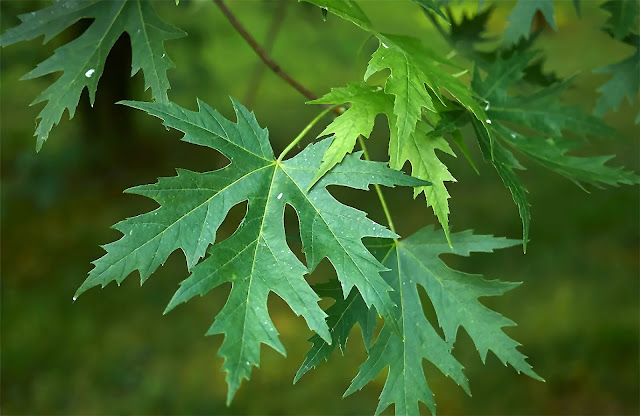Today's post will be about the Douglas Fir tree. The Latin name for this species is Pseudotsuga menziesii. What a mouthful. Thankfully, everyone [in Canada] seems to agree on just one name, Douglas fir, even though this tree is a pretender. But we'll get into that below. First, a photo of a Douglas fir.
This particular tree is called Big Lonely Doug. It was featured in a book called Big Lonely Doug by Harley Rustad. It's a good read, should you choose to pick up a copy.
Here's a range map, courtesy of Wikipedia:
The interesting thing is that this map suggests that Douglas fir only grows
naturally within BC and southwestern Alberta (within Canada).
However, although Douglas fir is planted very commonly in BC, we've
also planted small amounts of this species on select projects in the
Maritimes! Of course, it's not suitable for all projects on the east
coast, since it's not a naturalized tree. But some of the east coast
nurseries grow it. While I was digging around to find any history of Douglas fir in the Maritimes, I discovered that there was a plantation made near Stanhope (PEI) that was still healthy in the 1960's, and even today there may be other stands on PEI in Melville and Brookdale.
Douglas fir has a rich history in western Canada, and has been a critical part of the forest industry due to its value as lumber. While the tree was essentially unknown throughout most of North America in the 1800's, by the mid-20th century it had become known as "the world's premier industrial tree," taking the place of Eastern White Pine after all the old growth pine on the east coast had been decimated.
Douglas fir likes direct sunlight, but it is also shade-tolerant. Because of this, it can be found in pure even-aged stands (usually after a wildfire or a commercial harvest), in uneven-age stands, and also in mixwood forests. It is happy to co-exist among other species, especially hemlock, cedar, pine, larch, and even aspen. It doesn't like to grow up with spruce trees though. Maybe they get jealous of each other because of how straight and clean the trunks grow.
Douglas fir is considered to be a false fir. The real firs are species in BC such as Amabilis, Subalpine, and Grand Fir (or Balsam fir in Alberta and central/eastern Canada). Douglas fir is not a type of pine, spruce or hemlock either. Douglas fir is its own thing. The Latin family name (Pseudotsuga) means "false hemlock."
Being a conifer, the Douglas fir has needles instead of leaves. Here's a photo of the needles on a bundle of seedlings:
Some people have problems differentiating between Douglas fir, true firs, and spruce trees. That's not surprising. At a quick glance, anyone who hasn't studied trees could easily be fooled. But luckily, Nature has given Douglas fir a unique identifying feature for inexperienced silviculturalists: Pointy buds! The buds of the Douglas fir have a very distinct sharp point at the tip. Here's a close-up photo, from Step By Step:
Here are a few Fun Facts about the Douglas fir:
1. The Latin name for this tree (Pseudotsuga menziesii) is a nod to its "discoverer," Alexander Menzies (although of course the indigenous peoples lived with it for millennia before that). And Douglas refers to David Douglas, a Scottish botanist who introduced the tree to Europe.
2. Douglas fir is a deep-rooted species. However, the taproot usually achieves more than 50% of its final depth within just the first five years of growth!
3. The US Navy still has eight wooden ships in the active fleet (Avenger-class minesweepers) made out of ... you guessed it! Douglas fir.
4. An enormous Douglas fir was cut in Washington State in 1897 which measured 465 feet. After it was cut, the New York Times called its destruction a "truly pitiable tale." Indeed. This tree was called the Nooksack Giant, if you'd like to dig into that bit of history.
The Douglas fir is a very noble tree. The world needs more of them.
Thanks for reading!
Replant.ca Environmental is a Canadian company that plants trees for carbon capture and builds community forests. We also plant trees in national, provincial, and municipal public parks to mitigate damage from wildfires, storms, insects, and forest diseases. We operate thanks to numerous small contributions from the general public, in addition to larger project sponsorships from businesses and corporations around the world. If you'd like to learn how to show your support, visit our donations page. Even if you aren't able to make a contribution, we very much appreciate when people are able to share our posts or our website link on social media, to help spread the word about the work that we're doing!
Teachers are welcome to use content from this post for their classes. If you know a teacher who might like to use this information, please share it with them! The more that people learn about trees, the better our world will be.
To learn more about the various species that we plant, visit the conifers page or the deciduous (hardwoods) page on our website. Thanks so much for your interest!
Incidentally, our organization is often seeking additional land for our carbon capture projects. Please visit this link if you might know of a recently-harvested property that we could rebuild into a permanent legacy forest.










































